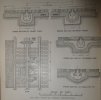Springs Branch
Established Member
If the OP is looking for interesting, non-standard and unique electrification systems, then we should include an honourable mention for a couple of industrial systems that have used electric traction. These are probably more like freight analogues of early 20th century street tramways than main line railways (e.g. used low voltage DC & obviously overhead line, never conductor rails) but were involved in moving full-size, standard gauge, "proper railway" rolling stock (usually coal wagons).
One example - not far from the Manchester - Bury line and even closer to the old Clifton Junction power station - was at the *CEGB's Kearsley Power Station.
This line transferred coal from BR exchange sidings to the power station. 4 steeple-cab locos ran on the steeply-graded line (not easily accessible to random visitors), powered by 500V DC tramway-style overhead. Coal deliveries by rail appear to have ceased sometime around the mid-late 1970s, ahead of the power station closing in 1980.
Some random photos:-

 flic.kr
flic.kr

Electrics at Kearsley by Kevin Lane, on Flickr

Kearsley power station, 1972 by Keith Halton, on Flickr
Another example was the **NCB's Harton Electric Railway on Tyneside, which operated with assorted elderly pre-WW1 German, plus five 1950s-vintage English Electric locos, closing around 1989. I couldn't easily find the voltage for the Harton system, but assume from the appearance of the overhead that it was somewhere in the 500 - 600 V "tramway" range. The pantographs seen on the locos in the following images were apparently salvaged from Sunderland tramcars.


Bo-Bo No.12 (EE 1794/1951 / Baugley 3351/1951) At Harton Low Staithes. South Shields. by Adrian Nicholls, on Flickr
* CEGB = Central Electricity Generating Board
** NCB = National Coal Board
One example - not far from the Manchester - Bury line and even closer to the old Clifton Junction power station - was at the *CEGB's Kearsley Power Station.
This line transferred coal from BR exchange sidings to the power station. 4 steeple-cab locos ran on the steeply-graded line (not easily accessible to random visitors), powered by 500V DC tramway-style overhead. Coal deliveries by rail appear to have ceased sometime around the mid-late 1970s, ahead of the power station closing in 1980.
Some random photos:-

Kearsley Power Station
One of 4 steeple-cab electrics that worked on the short but very steeply graded branch line from the exchange sidings adjacent to the ex L&Y Manchester to Bolton line to the power station in the background. I'm not sure which one of the 4 this is - I can't read the number. It was taken on a...

Electrics at Kearsley by Kevin Lane, on Flickr

Kearsley power station, 1972 by Keith Halton, on Flickr
Another example was the **NCB's Harton Electric Railway on Tyneside, which operated with assorted elderly pre-WW1 German, plus five 1950s-vintage English Electric locos, closing around 1989. I couldn't easily find the voltage for the Harton system, but assume from the appearance of the overhead that it was somewhere in the 500 - 600 V "tramway" range. The pantographs seen on the locos in the following images were apparently salvaged from Sunderland tramcars.


Bo-Bo No.12 (EE 1794/1951 / Baugley 3351/1951) At Harton Low Staithes. South Shields. by Adrian Nicholls, on Flickr
* CEGB = Central Electricity Generating Board
** NCB = National Coal Board
Last edited:










